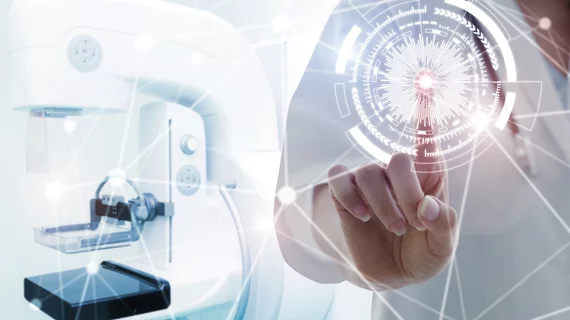Combining neural network with breast density measurements boosts interval cancer detection rates
Combining an artificial intelligence network with breast density assessments could increase interval cancer detection rates in women who have had negative screening mammograms, experts reported this week in Radiology.
Including breast density assessments in breast cancer risk models increases accuracy in predicting interval cancer, but researchers disclose that the accuracy is modest. With up to 30% of breast cancers developing in between mammograms, experts explain that “modest” accuracy simply is not enough for women with dense breasts who are already at an increased risk of breast cancer.
When cancer is not detected on the mammograms of these women, the use of artificial intelligence offers a potential solution.
“Studies have shown that precancerous mammograms contain unique imaging information beyond breast density that can be identified with deep learning networks, which can be used for risk assessment of breast cancer,” corresponding author Alexander J. T. Wanders, with the Dutch Breast Cancer Screening Program in the Netherlands, and coauthors explained. “Short-term risk prediction of interval cancer could be further improved by combining assessment of an AI breast cancer detection system and breast density within one neural network (NN)-based risk model.”
To test this theory, the researchers retrospectively analyzed the screening mammograms of almost 7,000 women imaged between January 2011 to January 2015. This included 2,222 women who were confirmed to have developed interval cancer (IC) and 4,661 in a control group.
An AI detection system assessed the likelihood of malignancy for all the exams on a scale of 1-10. A neural network was then trained to combine the AI scores with breast density assessments to fine tune patients’ risk prediction.
The NN model yielded an AUC of .79, which was higher than both the AI system and BD risk assessment. The NN had 50.1% sensitivity for predicting IC (339 out of 666 women), compared to 37.5% for the AI system and 22.4% when using BD measurement alone.
“This combination model had higher performance in predicting interval cancer development compared with the AI breast cancer detection system or breast density measurements alone,” experts noted. “The risk model has the potential to personalize current breast cancer screening programs by defining which women benefit from additional evaluation, aiming to reduce interval cancer rates.”
You can view the detailed research here.

